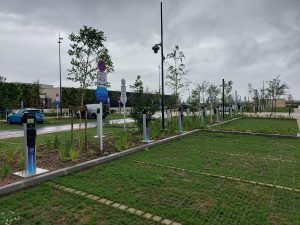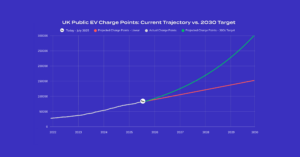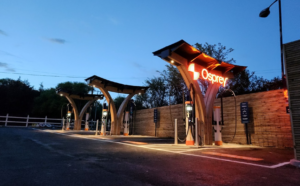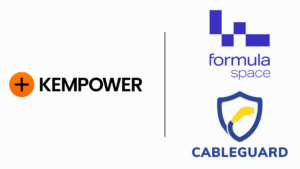EV charging infrastructure is scaling fast – but so are the challenges. Tight timelines, stretched budgets and growing complexity are pushing projects off course. So why are so many CPOs still suffering from disjointed delivery, delays and rising costs?
The answer lies in how the sites are delivered and more specifically, in the fragmented supply chains that are propping up a surprising number of projects during deployment. Too many site builds are still falling victim to scope creep, where small issues snowball into costly delays; if you’re managing multiple contractors unique to each site being delivered – you’ll know how scope creep happens.
This is why more infrastructure teams are moving towards a single source supply.
The Risk of Fragmented Delivery
Traditional delivery models often require our clients, usually charge point operators (CPO) and their delivery teams to juggle several third-party suppliers delivering different components of a site that are often reliant on one another, with one delay causing a chain-reaction of delays and costs akin to a sad Rube Goldberg machine with the final product being stress, costs outside of scope and delays. Scope creep is a common pitfall in project management, leading to delays, budget overruns and strained resources.
- 75% of construction projects experience scope creep
- 85% of projects with scope creep exceed their budget, with an average cost overrun of 27%
- 80% face schedule delays, averaging a 33% delay.
Source: Jared Formell | constrafor.com | Scope Creep in Construction Projects: By the Numbers | May 2023.
Whether it’s bollard, bay marking, charger wrapping, foundation installation, signage or CCTV, these elements are rarely integrated under one supplier from the outset and every extra supplier brings with it another point of failure whether it’s a delay, spec issue or missed deadline. With each failure in the process – each missed deadline, each surpassed budget – the ability to overlook quality issues grows ever stronger with the final product late, expensive and incorrect, with the responsibility lying solely with the internal project manager and the impact being felt by the end user.
Mitigating Scope Creep: Best Practices
Managing scope creep is a subject often written about, but with a unique insight into not just one but a broad range of project types, we feel we are uniquely positioned to speak on the issue.
Clear scope definition with alignment across all stakeholders
Successful projects begin with clarity. That means taking the time upfront to define exactly what is being delivered, by whom, how it is going to look, how that will be maintained across sites, how upgradability is maintained etc.
What this looks like in practice:
- Establishing brand, UX, and operational priorities before breaking ground
- Running structured discovery and design workshops
- Validating site layout and product mix against end-user needs and regulatory constraints. Looking at potential future behavioural, technical and legislative changes
These are the types of activity that often sit within early-stage planning but are frequently under-resourced and poorly executed in a bid to make progress that can be seen.
Change control without the red tape
Modifications to the plan are inevitable, especially when each site varies in location, size and layout, but uncontrolled change, is where scope creep begins. Having a clear, centralised way to review and approve changes keeps projects on track without adding friction.
Look out for…
- Centralised ownership of design and material design [For example, ensure signage is printed from a single source, avoiding pantone, font and wider branding discrepancies]
- Processes for reviewing spec-changes and re-costing in real time. Which stakeholders need to be involved, how will changes affect the timelines of other contractors, what about the local authority?
- Shared documentation sharable with a live link that is accessible across internal and contractor teams ensuring consistency and one place for key info updated in real time
Regular communication between design, delivery and site teams
Scope creep often results from breakdowns in communication between designers, installers, contractors and suppliers.
Project resilience improves when…
- All site elements are specified together, not separately
- Delivery teams know what is being manufactured, when it is delivered, when it requires installation and how to install it
- Documentation and training are built into the handover
Integrated Project Teams That Understand the Bigger Picture
Fragmentation kills momentum. The most effective projects bring together teams that understand not just the scope of that specific project in that location, but the full lifecycle of the site, the wider business objective and the activities being completed across the market area.
Good integration includes…
- A single point of accountability across site elements and across sites
- Joined-up thinking from brand to bollard
- Partners who don’t just supply, they advise, adjust and optimise
Best practices are only useful when they’re easy to implement. By aligning the delivery of key site infrastructure components under one coordinated partner, you not only reduce the opportunity for scope creep but you also raise the baseline for quality, speed, and brand consistency.
The Formula Space Approach: Single source. Complete oversight
After working on projects at every stage – from initial design to mid-deployment rescue missions – we’ve developed a single source supply methodology that improves consistency and reduces complexity.
We’ve worked across a variety of project types – joining partway through deployment, post-deployment, and at day one. Each time, we’ve seen first-hand how the Formula Space methodology – providing a single point of accountability for the entire delivery of the network – results in real cost savings, rapid deployment and maximum consistency. With Formula Space managing site deployment for EV charging, you get expert insights and a full suite of products as one coordinated package…
- On average 30% faster site delivery
- Eliminate the risk of site variations
- Cohesive site aesthetics, UX and branding
- Maximum site value with early access to industry innovation
The Formula Space customer-first model is designed to plug seamlessly into wider project planning, enabling delivery teams to receive everything they need in one drop. No chasing. No cross-referencing. Just results.












